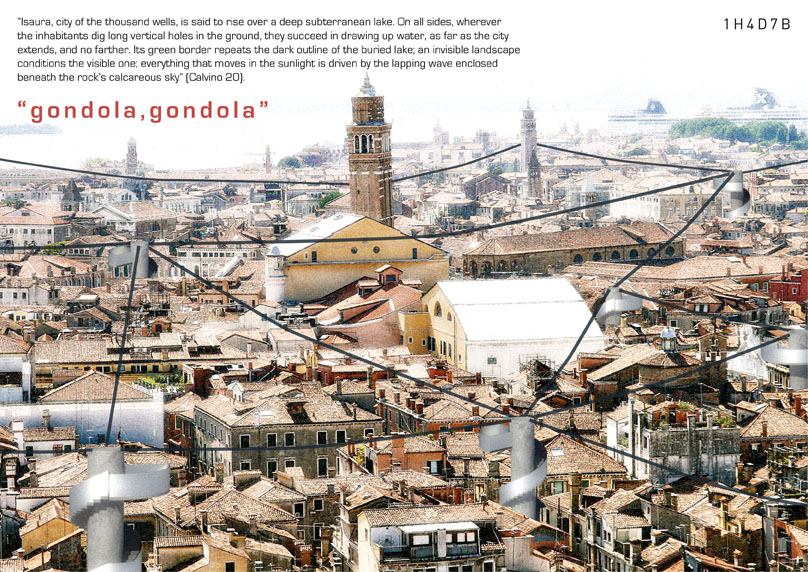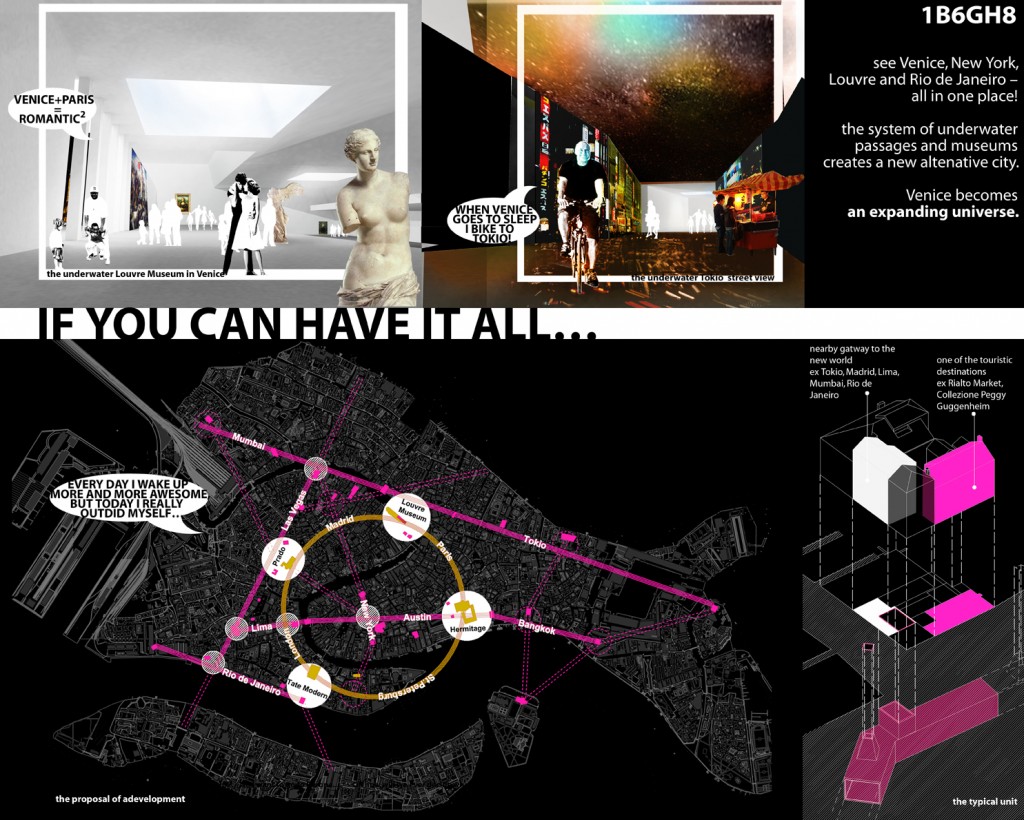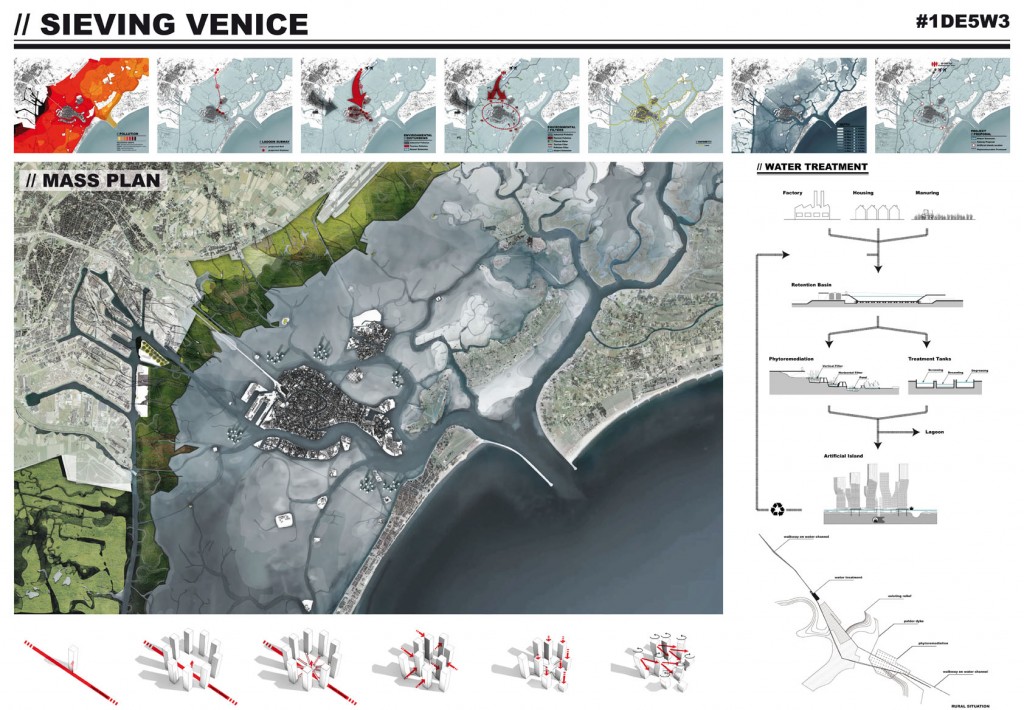Info:
Title: Sieving Venice - Code: 1DE5W3Contest: Venice / 2011
By: S. Al Khayer / M. Chapus
Views: 3781 Likes: 4
Votes:
BJARKE INGELS6 NERI OXMAN8 ELENA MANFERDINI7 MARIA LUDOVICA TRAMONTIN5 BOSTJAN VUGA46.0
Sieving Venice
?
Sieving venice Yesterday Venice was a place of refuge for the inhabitants of Northeast Italy. The exceptional geographical context offered by the lagoon of Venice, approximately 50 km long and 15 km wide, is 551 km ² of an amphibian environment made by islands more or less sank by a brackish water, perfect to avoid the Lombard invasions, but however contains dangers like the mudding, due to a loose ground, and the destructive assault of the waves which threatened the constructions. To mitigate this problem, rivers flows were diverted and disciplined, three ways by which the tide rushes into the lagoon are ceaselessly fitted out, and the slender offshore bar was protected from fences and from moles. At the same time, the city of Venice extended gradually in any possible piece of land of the lagoon, by taking care every time to strengthen the load capacity of the ground by the use of stilts.
In the XIVth century The city became then the most important port of the Mediterranean Sea and expanded its economy, policy, art, etc.
In spite of the living emancipation of the Turks in the XVIIIth century, Venice is losing the monopoly of coastal shipping business, the city maintained its cultural notoriety, by becoming the European’s most elegant and most sophisticated city of the century, with a strong influence on art, literature and architecture …
Today
In spite of its modernization, Venice tries ceaselessly to fit out its environment to control consequences on the historic city classified in the world heritage of the UNESCO.
In the first place, the phenomenon of the acqua alta which ate away slowly the brick-built porous walls is not any more a threat. Indeed, the MOSE project (Modulo Sperimentale Elettromeccanico) should prevent before 2014 water high rise from destroying Venice. These moving barriers which allow to isolate the lagoon of Venice from the Adriatic Sea when the tide reaches a level fixed to 110 cm.
Then, Venice developed a transport network for the city. The main part of the transport system and goods is made by water with gondolas, vaporetti, traghetti and other motorboats. Only the bridge Ponte della Libertà connects physically Venice to the land, and allows the railways and cars to link Mestre to the entrance of the city. This is why the city remains nowadays the only city free of cars and trucks.
Meanwhile, Venice loses its residential functions and becomes a “museum-city “. Venice dedicates itself indeed gradually to the tourism (it welcomes every year about 20 million tourists) which becomes rapidly one of the main resources of the city (about 1.5 billion Euros a year). So, in order to bring more tourists, the airport Marco Polo is enlarged in 2002, and a lagoon subway project was proposed connecting the airport and Venise-Fondamente Nuove in only 7 min.
But paradoxically, project set up by the city of Venice to protect the city and develop the tourism is leading to its loss. Tourists increasing, their excess in large number produces the worst phenomena of congestions and distort the original Venetian atmosphere.
boats and industrial parks are the origin of a massive pollution and defective systems of sewers aren’t able to negotiate. The polluting mass deriving from these sources is so considerable that it exceeds the capacity of the lagoon to make a process of regeneration of waters, remineralization of the organic components and the dilution of the non-organic components. The concentrations of these various substances put in danger the ecosystem of the lagoon and lead to a degradation of the built Venice, driving the city slowly to its destruction.
The given image of the future Venice is terrible: the lagoon, on the base of the power of Venice, is polluted, the ecosystem which lives in it is in danger, the water is destroying the historic city and the increasing tourist flow coming to testify the charm of the city are becoming actors of his its degradation. Struggling between two organic armies coming to delight in its charms, Venice has to fight against two types of pollution: environmental and human.
Tomorrow
The lagoon is not a permanent geographical criterion. Intervening in the process of a moving and unstable territory by taking into account the current parameters will be engaging a duality between artificial and natural processes.
The pollution released by Marghera factories and by all the coast should be channeled to manage polluting flows and rejections in the lagoon.
A system of polders in shallowed zones all along the coastline will be created giving a “strip” which will push away Mestre borders by proposing a passing space between polluting agents and the lagoon
This sieve will work as a water treatment regulation, using a system of water-treatment plants, and irrigation channels, phytoremediation zones. Leading to a transforming landscape where friction happens between natural, artificial and infrastructural. a monitored nature, a responsive nature regulating environmental disparities.
Meanwhile, Venice is reaching the threshold of its environmental balance and arriving at a saturation point due to the unavoidable and increasing tourism flow. That is why denying this parameter would be against its posterity.
By enlarging the Marco Polo airport, the project of the subway will drain more tourists to Venice. And by preventing the subway to arrive to Venice and re-qualifying the subway trajectory it would be more suitable for saving the city from the ultimate state of a” Post-tourism city”.
Artificial islands surrounds and overhangs Venice. By redirecting tourism flow from the airport to the proposed islands, it will strengthen the notion of a ” Museum City ” by staging it. These islands are composed by vertical typologies, high rise clusters with touristic programs and complete touristic services.
The emergence of islands would be referred to a metastatic process of the lagoon. These compact and dense towers will search for high points of view and and looking at specific sights on Venice, looking for the “cliché”, in order to be able to snap the “postcard” picture.
Islands will be connected to the existing boat networks. Mobility being the precondition for any metropolitan situation, so we cross the existing mobility with the arrival of the subway and make a new definition of the territory.
Connections between airport-metro-islands-vaporettis-Venice will be mobility places and intensive metropolitan situations.
Related Posts :
Comments:
Info:
Title: Sieving Venice
Time: 7 giugno 2011
Category: Venice
Views: 3781 Likes: 4
Tags: Adriatic Sea , Marco Polo , Mediterranean Sea , MOSE Project , New York City , Northeast Italy , Venetian Lagoon , Venice








